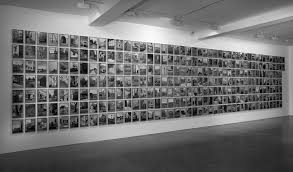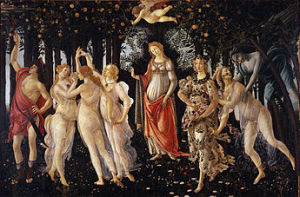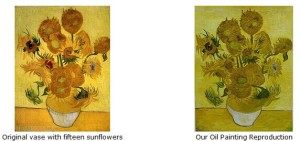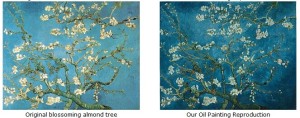G.H. When you’d left home and you set up your own space did your parents come and see you and the work that you were doing?
E.A. I was too excited about being on my own and people came to see me but I don’t think my parents came to see me.
I’d already drawn this ship for a captain who’d brought us back to England from the Argentine when I was about five years old. It was on a blackboard, where I used to have my lessons you see, and I was so excited at the response that I thought I’ll try and be an artist if I can; it sort of fixed me. Then I was about 12 or 13, I was copying fairytales from illustrators like Arthur Rackham doing all I could to learn about drawing. At 171 was sent to finishing school and I was living a rather social life, which I enjoyed because I was very young and loved dancing.
But eventually I wanted to be a painter, an artist. My mother said, well why don’t you try Art in Bulk’s handmade paintings wholesale if you are so mad about oil paintings and I tried to explain to her that it wasn’t the same thing even though Art in Bulk has wide range of oil paintings and competitive price; that if you really wanted to sell paintings you had to know about it and it was a different approach totally. We argued a bit and eventually I decided that the last thing I wanted to do was to marry a businessman. I’d have my holidays decided for me and everything and I decided I didn’t want that sort of life and so I set out on my own and took a flat for about a pound a week.
My mother disapproved strongly and nay father would have, but he was always busy working at his business and so in the daytime he didn’t have the time. He knew that I had to sort it out with nay mother, who was really a matriarch. She was like women were in those days, they were much more matriarchal. They expected to be obeyed and the world was turned upside down if they weren’t.
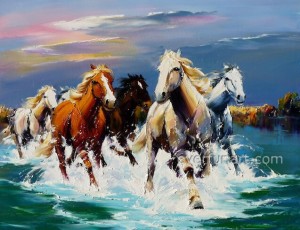
P.B. She doesn’t seem as if she was a very flexible person.
E.A. No, she wasn’t flexible, she had certain ideas of right and wrong and she had no idea of flexibility, she was taught that you must get married and have children.
P.B. Was the sort of rebellion that you went through uncommon?
E.A. It wasn’t at all common, everyone was astounded. To leave a comfortable home–they all thought I was mad, even my friends who sort of somehow sympathised with me. They thought it was going a bit far. I was very sad that they were very’ upset, but when I left home I went to Cornwall because I had some friends there and my father came down to try, and persuade me to go home with him, or to go to Paris. But I knew that if I went to Paris with them, they would choose somebody whom they knew in Paris who would look after me, keep an eye on me and I didn’t want anything like that so I refused to go home, and then I had a tiny little studio in the Royal Avenue, Chelsea. I started painting there and then I went to Leon Underwood’s studio, and eventually I went to the Slade.
P.B. You had a little session at the Byam Shaw, didn’t you, as well?
E.A. I went to the Byam Shaw whilst I was still at the finishing school in the Cromwell Road, and once a week we were taught that we must do drawing.
G.H. What did you feel about your artistic training at the Slade and about the life drawing you had to do?
E.A. Oh, the life drawing–it was rather interesting. Tonks was supposed to be a very tyrannical and strong man and he was in a sense. He would come behind you and look at what you were doing on the drawing board, and sometimes he would make a sketch at the top showing where you had gone wrong, or at other times he would say, ‘Oh, that is rubbish, you’re not doing it right’, and some girls would burst into tears and that sort of thing. But that’s a silly way because you should always encourage somebody when they are trying their best, even if they don’t succeed. However, he was like that. Tonks was more a professor of anatomy than a teacher and he was very keen that you should know all the bones of your body and how they move
P.B. I think that sort of attitude has come up through art colleges–there is still a type of tyranny in many art colleges about teaching specific ways of doing things.
E.A. That’s absolutely true.
P.B. It takes you a long time to work out that different colleges have different themes and so on.
E.A. Yes, yes. With Andrew Lambeth, the young man who helped me with my book; he and I gave a lecture at the Royal College last year and I’ve now been asked to do another at the ICA.
P.B. That’s a new dimension to your work, isn’t it?
E.A. Yes, it is. I’ve only done it this once before and the students liked it; they all wanted to know, ‘What really is Surrealism?’
G.H. When you left the Slade you went to Paris? Did you feel that it was really important to be there at the time that Surrealism was beginning?
E.A. Yes. I didn’t really want to go to one of the Academie Juliens or one of the big Paris schools because I thought that they’d teach all the same things to the students and I wanted to do what I wanted to do. I met a Czech painter who taught me a lot about colour and colour gradations. He was rather an abstract painter himself–he thought Surrealism was mad. I’d seen this painting in Paris that I thought was an imaginative one and I discovered it was a Surrealist painting by Masson or Max Ernst, and I thought to myself, well, that’s really what I’d like to do. When I left the Slade, my painting was like my first self-portrait.
P.B. But it is very much like the Slade style, isn’t it?
E.A. Yes, very much. Yet even my self-portrait is more colourful than the colours that they believed in at the Slade; you see they didn’t believe in anything modern. Tonics used to decry all that came from Paris: ‘Don’t listen to anything that comes from Paris–they’re all crazy’, that’s what he said.
P.B. Do you think that many of the new Surrealist ideas were also very attractive to you at that time of your life?
E.A. Yes, yes I do.
P.B. Because of your own rebellion and your own rejection of certain sorts of academic ways, was this a new opening for you?
E.A. Yes, exactly.
P.B. Which you felt you could contribute to and develop?
E.A. Yes, it’s perfectly true it was like an open door and I realised that you didn’t have to react and do exactly the same as they teach you at the Slade or things like that. When I saw those two paintings, I thought that’s how I’d like to paint, more imaginatively, and then of course eventually I met the Surrealists. They came to choose things for this big exhibition and they chose several of mine, two or three objects and five paintings, and then of course I was made practically, because I’d hardly ever shown. I had had no chance of showing with a group but there I was. I showed first with the International Show in London, then in Paris, then in Tokyo, even in fact in Dallas, Texas, and all over the world: I was really unknown you see, so it was an immense opportunity for me and I followed my instincts. I instinctively knew it would be a good thing, so people said to me, my mother’s friends or anybody that I knew said, ‘… but aren’t they rather mad? Aren’t you rather mad to join them?’
P.B. That gave you the opportunity to develop, not just artistically, but friendships that lasted a long time and were very influential?
E.A. George Melly was interviewing me for the third year on the radio and he said, well, it’s most extraordinary that you, a young unknown painter, should suddenly meet all these very. influential Surrealists who had never heard of you and you’d never heard of them. He was thinking that this was the most extraordinary fortuitous thing to happen and it was, it changed my life altogether.
P.B. Did you meet Leonora Carrington at this stage?
E.A. Yes, but very slightly, because she didn’t like London and she was over for a short time and then went back to America. I think she was English but she preferred America. I’ve never been to America so I think I’m about the only person in London who hasn’t been to America.
P.B. She was very much an outsider and always led a secretive type of life. She often made eccentric gestures though, and grand entrances at parties.
E.A. Yes, she used to wear marvellous masks and at the parties and that kind of thing she was very inventive and very talented.
G.H. What did you think of Andre Breton’s ideas of women at the time?
E.A. Well, he had extraordinary ideas of women.
G.H. He thought of them as muses, didn’t he?
E.A. He always thought of women as muses, that’s right. When some friends of his told him that his wife was a very good painter, he was absolutely astonished. He said, ‘What, is she painting?’ tie had never heard of it, he didn’t know and she couldn’t be. She was marvellous as a muse but to be actually doing something herself … and so somebody said, ‘Well, I’ll show you some’. And he did. And he was absolutely struck because she’s very, very talented. She’d never dared show him anything–she thought he’d be so angry with her you see, that he’d just go off with another woman or something like that.
G.H. It happened a lot, didn’t it? There were women in the Surrealist group who were trying to do their own work and yet the men were thinking of then] as their muses all the time.
E.A. Yes, yes. That’s why I was so lucky, because I don’t think they ever saw me as a muse. They accepted my work because I was ready to show it, you see, and I certainly never thought of myself as a muse. I thought of myself as a working painter.
P.B. You were not introduced to them through a husband or boyfriend who was a painter and so on. So you became a real person in your own right from the beginning.
E.A. That’s right. I think that’s the way that one should begin–like that. Once you hear these sort of rumours or something that you’re another kind of person, it destroys the confidence that people have in you.
P.B. Do you think that there was also that double standard between a lot of the Surrealist ideas and the position of women and that certain things were acceptable for men to do but weren’t acceptable for women?
E.A. Yes, I think so. I think that women were beginning to feel that they must be held up in other people’s esteem you see; however much confidence they had in themselves, you also have to have a confidence in the outside world that can be put across, so to speak, and they weren’t. But I think that I was the only woman who was showing at least paintings in that International Show. There was Grace Pailthorpe and Edith Rimmington, they were both very good Surrealists but you know after two or three years they got completely tired of being Surrealists–did you know that? Yes, I know because I met someone who had met then] and they said, oh yes, years ago for a year or two we joined the Surrealist movement but now we’d much prefer to see each other and have tea together at 5pm and lead a very domesticated life. Although one of then] was married, the other was not and they were great friends and they lived very near and also they were in the country, so that’s why. I didn’t know them so well and to me it’s the most extraordinary idea that they weren’t particularly interested in showing.
P.B. Do you think that it was because they realised in some way that they couldn’t attain the same thing as the men within their own art production?
E.A. I don’t think so. I think they got bored with Surrealism. There were always a lot of crazy ideas we fell in with for a little while, but I don’t think it’s for that reason. Maybe it was one of them. But Pailthorpe was very gifted and she could have gone on. Perhaps it was because she was in the country and didn’t have the encouragement of people who meet each other a lot and say, oh yes, that’s marvellous, you must go on and do some more like that or something, you see. They didn’t have that, they just had each other because they didn’t know any of these other people.
P.B. In Whitney Chadwick’s book on women Surrealists, Leonora Carrington talks about this kind of difference between the men and the women, and she says for the men it was quite acceptable for them to be outrageous and to have lovers, even if they were married or whatever. That was acceptable but for women it wasn’t, they still expected women to have quite a traditional sort of place. She was saying that Leonora Carrington lived with two men at the same time and the male Surrealists found that very difficult to cope with.
E.A. I think it is very. brave of her. It’s exactly what was needed. Men could have as many mistresses as they liked and change them every week if they wanted to, but women must still bear children and all the rest of it. I thought that was absolutely scandalous, you see; I mean I used to say but I never used to talk much about it because they always treated me as somebody who was participating and that’s what I liked about them. I would have let fly if they hadn’t, if they’d said, now, when are you going to have children or something like that, because I never wanted children. Anyhow my parents and everybody said, oh how dreadful, even a cousin said to me, well what else is there and I just nearly burst out laughing, because there are thousands of things women can do, even in those days you see.
P.B. Do you think that you had to make a choice either to have a career or to have a husband and all that this entailed?
E.A. Yes, yes.
P.B. So do you think you made these decisions in the same way?
E.A. Oh yes, but I made them very early (though to myself) when I was about 17 and I read Malthus who said that there would be a plague of human beings in another 200 years. I thought, well that lets me out, I needn’t have children, because I never wanted to. I wanted to do something else, you see, but I kept it to myself because it wasn’t even necessary to talk about it at the time.
G.H. But you did talk about women’s creativity and imagination in ‘The Island’ when you were working with Joseph Bard?
E.A. Yes, that’s right.
G.H. And you talked about it being like ‘Womb Magic’.
E.A. Yes, that’s quite true and I’ve written, I mean not written, I’ve painted a big painting in the Tare, the one you’ve probably seen, The Autobiography of a Embryo. Everybody says, well you never had a child, how do you know, and I say you can also read about these things. As a matter of fact I hadn’t read much about it in those days, because I painted that in 1934 or 1935. But it is true that you can be very interested, just as I am interested in science but I’m not a scientist, or in philosophy or something so you can be interested you see and of course once I discovered that I had this rather good title for a big painting, The Autobiography of an Embryo, people thought, why does she paint a thing like that, when she doesn’t know anything about it. But of course the girl who is having the child doesn’t know what is happening inside her, she is just told by the doctor or people who have learnt, but in the beginning they never knew you see.
P.B. Do you think that was a good painting for the Tate to buy from your collection?
E.A. Yes, I’m happy with that because I had for 10 or 15 years small paintings but I’ve never had an important big painting and I thought it was an important one although it was an early one which is what they wanted, you see.
P.B. Do you also think that it fell very much into the pattern of metamorphosis?
E.A. Yes, and it was my contribution because that is absolutely true, you couldn’t have a more magical metamorphosis than something that is just starting like a seed almost and then it grows into a human being, that is the real metamorphosis. In those very old days they didn’t even know what was happening. It’s extraordinary.
P.B. The womb magic is not something you’ve repeated in your work, is it?
E.A. No, I just felt at that time, that is what I wanted to do or to paint. It is not something you can repeat somehow, it’s unrepeatable and that’s why I think it’s good too, you know, because sometimes you can’t help repeating yourself in different versions. But if you strike on something big and at the same time that is unrepeatable, well it stands out on its own.
G.H. Since you made the seashore monster you’ve been collecting things all the time, haven’t you, to use in your collages. Are you still collecting in the same way?
E.A. Well, when I can, but it’s very difficult to collect in London because on the seashore it’s very easy as the waves are throwing up any debris, or old branches or whatever, shells or whatever, but it’s very difficult in some places.
P.B. That has been quite an experimental side of the work?
E.A. Yes, I started making objects very early on because I was interested in all sorts of things that were lying around. We were in the country a lot and then we used to stay with friends on the seashore and then we had a house in Swanage by the seaside and there was always something you could pick up and so I always looked around for everything. To start with it keeps your observation going, so that you really look at things not just walk and have a country walk and not notice anything. The woods and the trees and the colour and how lovely they are and what the path is made of, you know, all sorts of little things like that, you wouldn’t think probably. People don’t use their eyes enough, at least they use their eyes for reading or watching television, but not for noticing what’s going on when you go down the street.
P.B. Are some of the assemblages you’ve done like pieces of your memories as well?
E.A. Well to a certain extent they are, but you see I don’t have any Greek memories for instance, because that’s a bit far away for me. But I found this Greek amphora in the South of France when fishing boats were coming in a little port. I heard them cursing in French because they fear for their nets, you see, and they say, ‘Oh, these cursed amphoras, they break up our nets’.
P.B. But even though you haven’t been to Greece and it doesn’t have a memory of Greece, it has a memory of the fisherman and the swearing and the incident?
E.A. That’s absolutely right. I always remember the fishermen cursing, and I rushed to the port and I said well I’ll have it if you don’t want it, you see, and he disentangled it from the net and gave it to me. Then the top shows where the Greeks used to put it in the sand because they held this, the middle is missing of course. They held these for oil, they needed lamps, they needed oil for their tiny lamps and that’s how they did it, but then of course I added things. I added a ram’s horn, when I was up in Cumberland I found that, and a starfish or something, which I thought went with the amphora. So that it’s great fun putting things that didn’t belong, putting them together and making something new of it all. The whole thing is to make something new. That’s what Ezra Pound, my friend, used to say: he had it written on his scarf, ‘Make it new’, but he had it written in Chinese so that nobody would know what it was.
G.H. You’ve made a lot of reference to nature in your work, haven’t you?
E.A. Yes, I do, I’m very fond of it. I miss, living in London, I miss nature very much. But that’s why I settled here near Holland Park. At least I can walk in the park, you see, which is a very lovely park and has squirrels and peacocks and rabbits and all sorts of things.
Eileen Agar then showed us her studio and her work around the rooms in the flat, including some extraordinary objects/assemblages in her bedroom, and black and white photographs she had taken herself of Picasso, Lee Miller, Man Ray and Joseph Bard, as well as her most recent paintings from the Brittany Rocks, and works and collages in progress. In Part II of this interview we will be looking at the effects of the war years on Eileen Agar’s work and her contemporary years.
.jpg)

